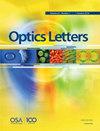基于几何投影身份的条纹投影轮廓三维重建。
IF 3.3
2区 物理与天体物理
Q2 OPTICS
引用次数: 0
摘要
本文揭示了FPP系统中的两个特殊几何点和一个几何投影恒等式(GPI),从而为四种常用方法(Ver3, Hor3, OptE3和HorVer4)提供了新的三维重建方程。我们证明了基于gpi的重建框架和传统的重建框架是等效的,但前者可以更快地进行点云计算和有效的计量精度分析。本文章由计算机程序翻译,如有差异,请以英文原文为准。
Geometrical projection identity-based 3D reconstruction for fringe projection profilometry.
This Letter reveals two special geometric points and a geometric projection identity (GPI) within an FPP system, thereby providing new 3D reconstruction equations for four common methods (Ver3, Hor3, OptE3, and HorVer4). We prove that the GPI-based and the traditional reconstruction frameworks are equivalent, but the former enables much faster point cloud computation and effective analysis of precision for metrology.
求助全文
通过发布文献求助,成功后即可免费获取论文全文。
去求助
来源期刊

Optics letters
物理-光学
CiteScore
6.60
自引率
8.30%
发文量
2275
审稿时长
1.7 months
期刊介绍:
The Optical Society (OSA) publishes high-quality, peer-reviewed articles in its portfolio of journals, which serve the full breadth of the optics and photonics community.
Optics Letters offers rapid dissemination of new results in all areas of optics with short, original, peer-reviewed communications. Optics Letters covers the latest research in optical science, including optical measurements, optical components and devices, atmospheric optics, biomedical optics, Fourier optics, integrated optics, optical processing, optoelectronics, lasers, nonlinear optics, optical storage and holography, optical coherence, polarization, quantum electronics, ultrafast optical phenomena, photonic crystals, and fiber optics. Criteria used in determining acceptability of contributions include newsworthiness to a substantial part of the optics community and the effect of rapid publication on the research of others. This journal, published twice each month, is where readers look for the latest discoveries in optics.
 求助内容:
求助内容: 应助结果提醒方式:
应助结果提醒方式:


